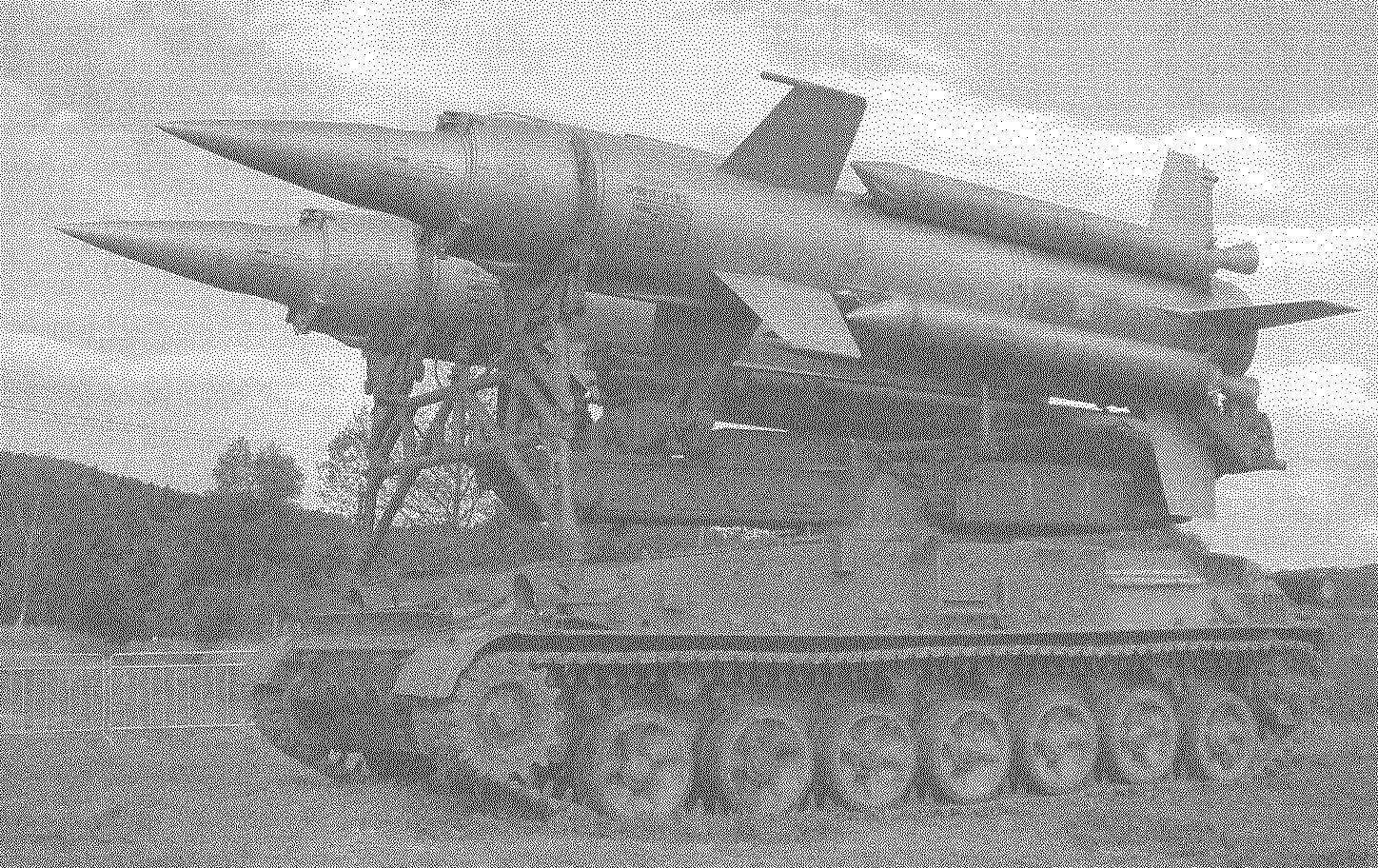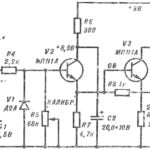 In the mid-1950s it became apparent gradual lag of the arms of the Soviet army air defense assets from the reached by that time, the capabilities of air attack. Continuous improvement of aviation, the emergence of tactical ballistic missiles set increasingly high requirements before the antiaircraft means of the ground forces, requiring them to qualitative leap. To achieve it it was possible only through the creation of army air defense anti-aircraft missile systems (3RK), possessed a number of specific features.
In the mid-1950s it became apparent gradual lag of the arms of the Soviet army air defense assets from the reached by that time, the capabilities of air attack. Continuous improvement of aviation, the emergence of tactical ballistic missiles set increasingly high requirements before the antiaircraft means of the ground forces, requiring them to qualitative leap. To achieve it it was possible only through the creation of army air defense anti-aircraft missile systems (3RK), possessed a number of specific features.
These 3RK was to act as a centralized and Autonomous, carrying out search and target acquisition radar division. High probability that the actions of the ground troops with the participation of a large number of armored vehicles will be dynamic and agile, is required to protect them using SAM, with a deployment time of 5 — 10 minutes. Thus SAM army should have high mobility and maneuverability, equipped with equipment navigation and topographic location, equipped with means of telecode radio communication for exchange between a team and technical information, automation of all combat operations, have built-in aggregates supply. The required level of reliability and readiness during the operation the troops were to support highly mobile station repair and control.
For the first time the task of creating a SAM army was formed in the decree of the USSR Council of Ministers dated March 27, 1956, providing for the development of complex, capable of hitting aerial targets at ranges up to 20 km, in the altitude range from 2 to 12 — 15 km and at speeds up to 600 m/s. However, this work did not come out of the stage of the project So the decision of tasks of military defense the next few years had to perform the s-75 and s-125.
In the late 1950s, the Soviet leadership came to grips with the issues facing military defenses. In August 1958, was formed a separate branch, air defense of Ground troops. Shortly before the military-industrial complex (MIC) has launched the first full-scale work on the creation of a SAM army — complexes “Circle” and “Cube”, in the tactical-technical requirements which set the above parameters on the terrain, time of bringing in readiness, resiliency between the means of the complex.
The user program of the first military 2К11 SAM “Circle” was commissioned 31-year-old chief designer of the Moscow NII-20 Benjamin p. Efremov.
Initially, the “Circle” was intended to engage targets flying at speeds up to 600 m/s at altitudes from 3 km to 25 km at the distance of 45 km., its members had to enter the station detection and targeting 1С12 (primary contractor — NII-208), the station missile guidance 1С32 (NII-20). An unexpected problem has caused a choice of the developer of rockets. Adopted 13 February 1958 a joint Resolution of the CPSU Central Committee and USSR Council of Ministers on the development of means of military SAM “Circle” was not mentioned already recognized by the time the authorities in the field of creation of anti-aircraft missiles OKB-301 Lavochkin and OKB-2 P D Grushin the Development of missiles for the “Circle” from the very beginning gained a competitive nature One of those who has received a proposal for its development, became the engine of OKB-670 M. M Bondaruk the Reason for this unusual choice was the fact that the first estimates showed what is the basis for the design of the new rocket will be the ramjet engine. But M. Bondaruk rightly reasoned that if the motor part of his KB well, with all the other elements of the missile — the development of the airframe and a variety of equipment is unlikely.
Some time on his own, rocket-134, worked in the CRI-58, led by the famous artillery designer V. G. Grabina. However, in the summer of 1959, after the merger of TSNII-58 to OKB-1 Queen, this topic is closed as not coinciding with the main direction of work of the enterprise.
As a result, “Round” gave artillery of Sverdlovsk OKB-8, which is a cool effect on the further fate of the enterprise to Its head, Lev Veniaminovich Lyulyev, reacted to the task of designing a new missile with a large, though not all justified optimism. As he spoke further. “At that moment I didnít have any missiles and had not provided all of the difficulties we have to meet when their development”. But as time has shown, Luliu managed to find the right ways and approaches to this work that was started with accelerated training. In order not to lose precious months in search of young specialists, finished profile (mainly Moscow) institutions, or to persuading management of other KB to let go of the “extra” missile specialists, Lulav, with the support of the leadership of the military, agreed about the direction of their leaders at OKB-2 PD Grushin, to work as interns in the design and engineering departments. Acquiring so much needed initial knowledge and experience, the locals started to design their rockets. As students, they were more than capable. They created a rocket and launcher is different from analogues innovative solutions.
Initially, the rocket for the “Circle” was created in two versions, with different guidance systems: ЗМ8 with radio command, and ЗМ10 combined — radio command on the primary site and homing in using semi-active radar head — on end But later decided to ЗМ8.


Anti-aircraft guided missile ЗМ8М SAM “Circle-M”:
1—Central body of the air intake; 2—gargrot; 3—ring fuel tank propulsion RAMJET; 4—the anti-flatter rocker, 5—console rotary wing, 6—chamber solid-fuel boosters; 7—console stabilizer; 8—antenna channel radio control 9—operating stub of the inlet; 10—compartment of the warhead, 11 —electrogoth; 12—cutter attachment operating the plug; 13—mechanism of repulsion of the sectors performance stub air intake; 14—starter bracket; 15—a stopper of the charging nozzle of the pneumatic system; 16 cover filler pad fuel RAMJET, 17—cap drain fuel RAMJET sustainer; 18—combustor RAMJET propulsion; 19—the front attachment point of the accelerator; 20—tube fitting air inlet during ground tests missiles; 21 —charging tube fittings pneumatic RAMJET propulsion fuel tanks; 22—emphasis mounting stub operational RAMJET sustainer; 23—maintenance hatch instrument module; 24—rear mount boosters; 25 —nozzle propulsion RAMJET, a 26—fuel filler main fuel; 27—operating plug nozzle propulsion RAMJET; The 28—tear-off portesham; 29—crank latch console stabilizer, 30—fairing boosters; 31 —pyrotechnic ejection mechanism of the booster; 32—cover of the combustion chamber of the accelerator, 33—rear attachment point of the accelerator, 34—pirovich starter accelerator; 35 and 37 of the airfoils of withdrawal of the accelerator; 36—nozzle solid-fuel boosters
Rocket ЗМ8 was performed on the aerodynamic X-shaped diagram with rotary wings; and stabilizers — scheme “+”.
The design of the rocket was two stage with a solid propellant booster and a RAMJET sustainer operating on kerosene. This propulsion system is several times larger than energy other types of rocket engines. At high supersonic speeds it was more efficient than the turbojet engine, had a simple design and was relatively cheap. However, these virtues concealed many problems, the solutions to which many missile troops at the time had only the most approximate judgment.
In the final design the body of the sustainer stage of the rocket was a supersonic ramjet engine ЗЦ4 with a recessed Central body, which houses the warhead weighing 150 kg, radio controlled fuses and the ball-cylinder air pressure accumulator. Further along the path of the engine was located rectifiable grid, the blocks of the nozzles and stabilizers burning. The fuel supply was provided turbopump unit, which used a monopropellant isopropylmalate. In the Central part of the annular engine casing was located tanks of kerosene, servos, the attachment points of the wings and tail — blocks of the control equipment.
The start and acceleration of the rocket to supersonic speeds was provided by four solid-fuel boosters side ЗЦ5 from the launcher 2П24. For the separation from the sustainer stage on each of them secured a pair of small airfoils.
The launcher was created in OKB-8 on chassis 100-mm self-propelled guns SU-100P. Artillery unit launcher included support beam with hinged in the rear part of the boom, raised by two hydraulic cylinders. On the sides of the boom is attached to the brackets with bearings to accommodate two missiles. The rockets can run at an angle from 10 to 55 degrees to the horizon. When you launch front support abruptly leaned down, freeing the path for passing the lower console of the stabilizer. Rocket in the process of acceleration was supported by additional supports also mounted on the boom One support truss was applied to the front and recorded two missiles Still on one leg was closer with the sides opposite the arrow.
Throwing the first launch products ЗМ8 equipped with a full-scale launch engines, took place on 26 November 1959 Rocket energetically came down with a launcher, however, the separation of the boosters were destroyed. However, for a young team the result of the first start-up was more than decent. And soon began trying to fly with a working sustainer engine, during which the locals had to deal with many previously unknown problems. So, first start attempt in-flight main engine was accompanied by the appearance of the surge, during which the rocket lost the handling As noted in the future one of the participants of these works: “Each RAMJET is unique in its specific design. Had to burn about ten thousand of the injectors before it was found its optimal form Every step when working out was hard and was done from scratch”.
Demanded further study the issues of vibration on-Board equipment missiles and shielding of the antenna of the defendant from the products of combustion of the main engine. With the latter was associated shown in the first launches ЗМ8 the problem of “31 seconds” after which the radar 1С32 several times lost the signal side of the defendant. The solution to this problem found, V. p. Efremov, who proposed to move the transmitter / receiver antenna with the rocket body to the stabilizer. In General, by the end of 1960, 26 missile launches, successful was only 12.
But by this time close on the heel of ЗМ8 started to attack another member of the competitive development. OKB-2, proposed missile 19D. The proposal for the “Circle” the missile arrived in early 1959 after the release of the draft design for the rocket 17D intended for use as part of the upgraded s-75, and naval air defense missile system M-31 issued July 4, 1959 the resolution of the country’s leadership, this initiative was supported.
Work on 19D was transferred to the Moscow branch of OKB-2, because by the time the main problems in the creation of 17D was considered close to resolution, and 19D had to differ from it only elements of the control equipment that is compatible with the guidance systems of the “Circle”. By April 1960 , the branch prepared a preliminary draft and produced the main part of the technical documentation needed to manufacture prototypes of missiles But soon the number of failures in trials of 17D has stalled, and the full documentation for 19D transferred to the plant only in February, 1961 due To the proposed earlier timing of the test of the “Circle” like a rocket ЗМ8 and 19D were disrupted.
In early February 1961, the heads of the enterprises working on “the Circle”, was summoned to a meeting of the Commission on military-industrial issues under the USSR Council of Ministers, where they were harshly criticized by the Chairman of the Commission D. F. Ustinov. Soon it was released the Commission’s decision “About the poor state of works on creation of a military anti-aircraft complex “Circle”. It was noted that most companies “… are not fulfilled in a timely manner the development and disrupted the established government document time of presentation of the complex on joint tests ., made a significant lag in the development of the prototype of the guidance station, …slowly lead the testing of missile …the production of missiles does not ensure normal running of the tests.”
However, the first real results from this “shake-up” received only towards the end of 1961, although all the participants made a maximum effort to achieve them. So, on 25 August, after another series of failures at start-up ЗМ8, set up a special Commission, which drafted proposals for the next revisions of the rocket — remove burnouts combustion chamber of the main engine, failure of the onboard equipment, insufficient strength of structural elements.
In the fall of 1961 to replace the experimental model of the system used for comprehensive factory testing, on the range of profit elements of the first prototype. At the end of the year, the first ЗМ8 prepared for testing in a closed loop guidance and received confirmation of the correctness of the decisions taken by the developers of the complex, then started to Refine his equipment, including the control system. Then, after receiving information about the first successful start ЗМ8 in a closed loop, Ustinov demanded from the developers of the “Circle” to start the joint testing in March 1962.
However, 1961 cannot be called successful for its developers. Now the rates achieved by the developers of the “Circle” already were late developers 19D. In the same 1961 produced and sent to the landfill only five such missiles, launchers 2П28 made especially for her in a single copy on the basis of the SU-1 PLO, was able to run only one. Poorly developed work and the missile 17D. The next stage in the decision about her fate was the period from February to may 1961, when it was planned after practicing 17D in the control loop, s-75M. But in this period have been impossible to meet. After April 20, 1961, was adopted С75М SAM with a rocket 20D, the tension in the works for 17D beginning to subside. The process of its refinement became increasingly resemble the work of test flying laboratory, which performed testing of promising solutions. And, ultimately, in the summer of 1963 working at 17D and 19D stopped.
Meanwhile, in the winter of 1963 the prototype of the “Circle” with missiles ЗМ8 was first demonstrated on the ground in Kubinka management of the country. And Embosom the ground by that time it was his intense trials, which are at the final stage mainly took place successfully. After a few dozen launches of the state Commission under the chairmanship of A. G. Burykina recommended the complex to the adoption. October 26, 1964, left the corresponding decree of the country’s leadership, and after a year, November 7, 1965 launchers “Circle” with missiles ЗМ8 was first shown at a military parade on red square in Moscow.
In General, the developers of the “Circle” was able to perform most of the set in 1958 requirements So that the range of the complex ranged from 11 to 45 km, elevation to engage targets from 3 to 23.5 km at a speed of their flight up to 800 m/s. the response time of the complex was 60 s, the mass of the rocket — 2450 kg. At the same time, the results of state tests was compiled from more than hundreds of comments and suggestions that were offered to implement further work on the “Circle”. The main ones were:
— extension of the affected area of the “Circle”;
— improving the efficiency of shooting at some points of the affected area, especially at low altitudes;
— the definition of the accuracy characteristics of the radar in the presence of a “mirror” surfaces.
These works are expected to be implemented in several stages. As a result, in 1967 it was adopted by the SAM “Circle-A”, which managed to reduce the lower boundary of the zone of destruction up to the height of 250 m and zoom near the boundary up to the distance of 9 km.
The next stage of the work, in 1971, was adopted by the SAM “Circle-M”, the far border of the kill zone which was increased to 50 km, and the top — up to 24.5 km.
The next version of SAM “Krug-M1”, adopted in 1974, was able to hit targets at minimum altitudes of 150 m and a minimum range of 6 — 7 km.
For several decades SAM “Circle” was in service with air defense units of the Land forces of the USSR, Warsaw Pact countries and several countries in the Middle East. And although during his many years of service this complex has never participated in the fighting, its creation and operation was an important event in the history of development of domestic military defenses.
In the 1990s, at the very end of the combat career of the complex “Circle” on the basis of the family of rockets was developed ЗМ8 target 9М319 “Turn.”
The main characteristics of the SAM the SAM “Circle-M”
The affected area, km
range………………9-50
height……….. 0,25—24,5
the parameter … …………18
The probability of hitting the fighter
one missile…………………0,7
Maximum speed
the targeted objectives, m/s……….. 800
Reaction time, with……………….60
Maximum
the speed of the rocket, m/s……..800-1000
Missile launch weight, kg…………2450
Warhead weight, kg……..150
Banalnosti target………………1
Banalnosti by Zur………………..1
Deployment time
(clotting), min………………..5
The number of missiles
on the launcher, PCs…………..2



